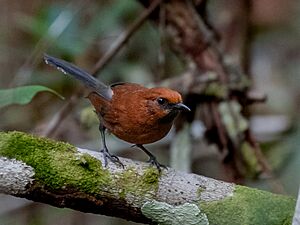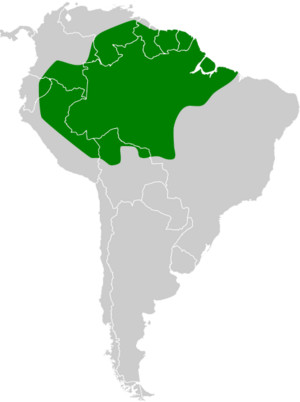Ruddy spinetail facts for kids
Quick facts for kids Ruddy spinetail |
|
|---|---|
 |
|
| Conservation status | |
| Scientific classification | |
| Genus: |
Synallaxis
|
| Species: |
rutilans
|
 |
|
The ruddy spinetail (Synallaxis rutilans) is a small bird that belongs to the ovenbird family called Furnariidae. You can find this bird in many South American countries. These include Bolivia, Brazil, Colombia, Ecuador, Guyana, Peru, Suriname, and Venezuela.
Contents
Meet the Ruddy Spinetail
The ruddy spinetail has seven different types, called subspecies. These are like different versions of the same bird. They have small differences in their looks or where they live.
- S. r. caquetensis
- S. r. confinis
- S. r. dissors
- S. r. amazonica
- S. r. rutilans
- S. r. tertia
- S. r. omissa
This bird is also related to other spinetails. These include the stripe-breasted spinetail and the chestnut-throated spinetail.
What Does a Ruddy Spinetail Look Like?
The ruddy spinetail is a small bird. It is about 13 to 15 centimeters (5 to 6 inches) long. It weighs between 15 to 22 grams (0.5 to 0.8 ounces).
Adult male ruddy spinetails have a deep reddish-brown face. Their front head is also reddish-brown. The back of their head and neck are brownish with some olive color. Their back is also brownish. Their tail is dark and looks a bit pointed.
Their throat is black. Their chest is bright reddish-brown. Their belly and under-tail feathers are dark olive-brown. Their eyes are brown or reddish. Their beak is black, sometimes with a gray bottom part. Their legs and feet are olive-gray or dark gray.
Female ruddy spinetails look a little lighter in color than males. Young birds are duller and less reddish. They have a gray throat and some faint stripes on their belly.
Different subspecies have slight color variations:
- Some have more reddish-brown on their head and back.
- Others are paler reddish-brown overall.
- Some have a brownish color on their head and back.
- One subspecies, S. r. omissa, is mostly sooty (dark gray) with reddish-brown only on its wings. It looks very different from the others.
Where Do Ruddy Spinetails Live?
Ruddy spinetails live in different parts of South America. Each subspecies lives in a specific area:
- S. r. caquetensis: Lives in central Colombia, eastern Ecuador, and northern Peru.
- S. r. confinis: Found in northwestern Brazil, west of the Rio Negro river.
- S. r. dissors: Lives from eastern Colombia through southern Venezuela and the Guianas. It also lives in northern Brazil, east of the Rio Negro.
- S. r. amazonica: Found in eastern Peru, northern Bolivia, and western and central Brazil.
- S. r. rutilans: Lives in central and eastern Brazil, between the Tapajós and Tocantins rivers. It also goes south into northeastern Mato Grosso.
- S. r. tertia: Found in southwestern Brazil and eastern Bolivia.
- S. r. omissa: Lives in eastern Brazil, from the Tocantins river east into northern Maranhão state.
These birds mostly live in the dense plants under tall trees in terra firme forests. These are forests on higher ground that do not flood. They also live in tropical lowland evergreen forests. They are usually found below 900 meters (3,000 feet) in elevation. In some areas, they can be found higher, up to 1,200 meters (3,900 feet).
Ruddy Spinetail Behavior
Movement
The ruddy spinetail stays in the same area all year round. It does not migrate to different places.
Feeding Habits
Ruddy spinetails eat many different kinds of arthropods. These are small creatures like insects and spiders. They usually look for food in pairs. Sometimes, they join groups of different bird species that are also looking for food.
They find their food by picking it off leaves, small branches, and dead leaves. They also search in leaf litter on the ground. They usually stay in thick bushes and plants, up to about 2 meters (6.5 feet) above the ground.
Reproduction and Life Cycle
The ruddy spinetail builds a special nest. It is shaped like a ball and made of twigs. It has a tunnel-like entrance on the side. A female bird usually lays three to four eggs. Scientists are still learning more about how these birds raise their young.
Vocalization
The ruddy spinetail has a unique song. It sounds like two notes, "keéwoh," repeated over and over. The second note is lower. Some people describe its song as "tac, tac-owet" or "kít-naaa." Others hear it as "chíck-dawah" or "keé-kawów."
Ruddy Spinetail Status
The IUCN (International Union for Conservation of Nature) says the ruddy spinetail is a species of "Least Concern." This means it is not currently in danger of disappearing. It lives in a very large area. Even though its population size is not known, it is thought to be decreasing.
No major threats have been found for this bird right now. It is considered common in many parts of its home range. However, it is "scarce and local" in Ecuador. The ruddy spinetail lives in many protected areas, which helps keep its population safe.
Images for kids



